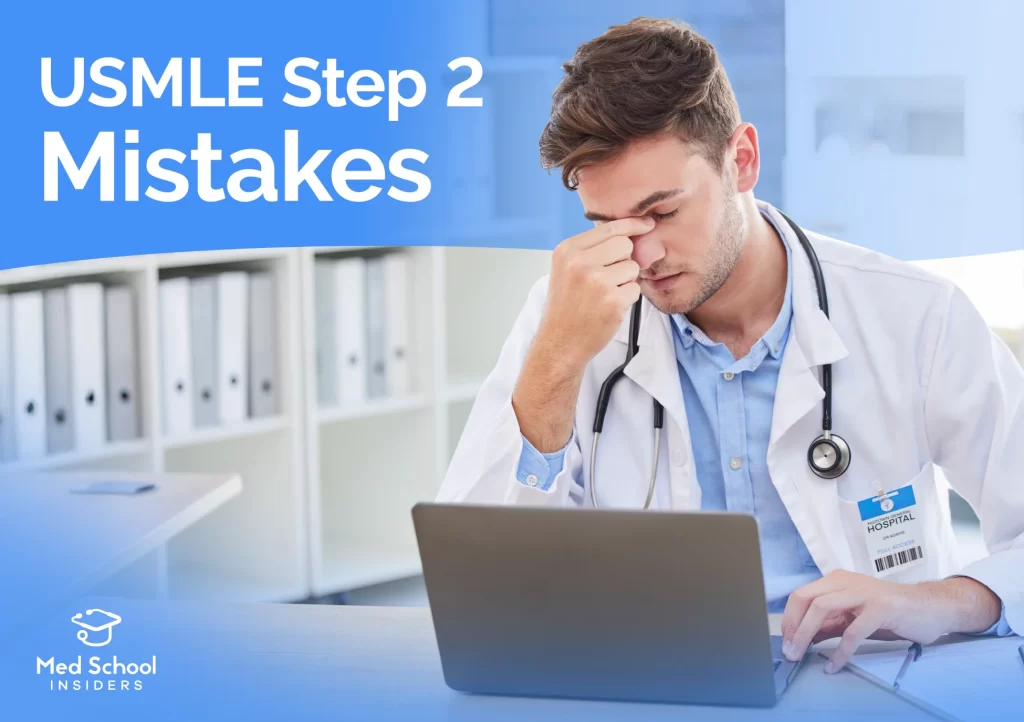USMLE Step 2 CK is a major medical school test that evaluates a student’s ability to apply their medical knowledge and understanding of clinical science to patient care. Residency programs consider Step 2 to be a benchmark of your progress in medical school, so it’s absolutely vital that your score be as optimal as possible—especially if you hope to match into a competitive specialty.
Our Step 2 guide will dig into what Step 1’s pass/fail change means for Step 2, the best resources to use, the importance of clerkships, Step 2 prep strategies, and FAQs.
Scroll below for the following topics:
- What Is USMLE Step 2?
- How Long Is Step 2 CK and What Is the Exam Format?
- USMLE Step 2 Percentiles
- USMLE Step 2 Registration and Scheduling
- When Do Students Take Step 2
- Eligibility and Scheduling
- Creating a Study Plan: Pre-Dedicated and Dedicated
- Ideal Step 2 Study Resources
- USMLE Step 2 CK Prep Tips and Advice
- Don’t Over Resource
- Practice Ethical Judgment Questions
- Understand the Format
- Make the Most of Clerkships and Shelf Exams
- Schedule a Simulated Step 2
- Prioritize Wellness
- What to Expect on Test Day
- USMLE Step 2 CK FAQ
What Is USMLE Step 2 CK?
The United States Medical Licensing Exam (USMLE) is a 3-part test designed to assess a student’s medical knowledge and ability to apply that knowledge to patient care.
Step 2 Clinical Knowledge (CK) is designed to evaluate your ability to apply medical knowledge, skills, and understanding of clinical science essentials to situations involving patient care. Step 2 CK focuses on the principles of clinical sciences and basic patient-centered skills, which provide the foundation for the safe and proficient practice of medicine under the supervision of an established, professional physician.
Many consider USMLE Step 2 CK to be a second chance for students who did not perform as well as they could on USMLE Step 1. However, now that USMLE Step 1 is Pass/Fail as of 2022, the weight of Step 2 CK has increased drastically.
The new pass/fail nature of Step 1 essentially shifts the pressure to Step 2 CK, making it the major objective measurement for clinical knowledge and assessment. Step 2 CK is the new Step 1, which means it is vital students crush it. If not, their chances of matching into a competitive residency are slim.
How Long Is Step 2 CK and What Is the Exam Format?
Step 2 CK is a one-day examination. It’s divided into eight 60-minute blocks and administered in a single 9-hour testing session. Just like Step 1, question blocks will not exceed 40 questions per block, which means the total number of items on the overall exam will not exceed 318.
USMLE Step 2 Percentiles
Currently, the minimum score to pass USMLE Step 2 CK is 209. The theoretical maximum is 300. The national average is 243, with a standard deviation of 16. Highly competitive specialties, such as plastic surgery and dermatology, demand that students perform well on Step 2 CK to be considered realistic candidates.
Want to maximize your score? Learn How I Scored 265+ on Step 2 CK.
USMLE Step 2 Registration and Scheduling
When Do Students Take USMLE Step 2?
USMLE Step 2 CK is typically taken at the end of third year (MS3) or during fourth year (MS4) after students complete their core rotations.
Eligibility and Scheduling
Generally, depending on your program, scheduling Step 2 is a bit more flexible than Step 1, but it operates much the same way.
You are eligible for Step 2 CK just by being enrolled at an accredited school, and technically, you can take the exam whenever you want. You can even take it before Step 1, though this is not advisable, as you likely won’t have enough clinical knowledge or experience to perform optimally. That said, your specific scheduling options depend on the policies of your medical school.
Just like Step 1, test dates at Prometric test centers are available six months in advance. In order to ensure you get the date and location you want, register for Step 2 CK at least six months in advance.
You will input your demographic information and medical school when you register. Prometric will check with your school to determine if you are qualified, and once that’s confirmed, you will receive a token to schedule your test. Timing will depend on your school, as some schools take several weeks to review your information and release your token. This is why it’s essential to be proactive and get started as early as possible.
When you have your token, return to the site where you registered and choose your eligibility window, which is the three month period when you can schedule your exam anywhere in the country.
You can move your test date within your three month eligibility period up to 45 days in advance of the test date for free, which is why it’s so important to schedule early. If you try to reschedule your test date within those 45 days, you’ll have to pay a fee.
You cannot change your eligibility period. While you can request a one-time eligibility period extension, it has to be directly after your current eligibility period. You cannot re-pick your eligibility period outside of that window. Step 2 CK costs $660. If you try to schedule an exam outside of your eligibility window, you will not be refunded.
USMLE Step 2 CK Resources
UWorld
UWorld is a comprehensive question bank. It’s considered by most students to be the highest-yield resource for all the Step and shelf exams because, in terms of both content and difficulty, the questions are quite similar to the ones you’ll find on the real thing. The explanations, diagrams, and tables that come with each question are also very useful when reviewing information for Step 2.
AMBOSS
AMBOSS is another question bank with USMLE-style questions, but it was originally designed specifically for Step 2, which makes it especially useful this time around. It comes with a clinical library many students find particularly helpful during the clinical years of medical school and has the added benefit of allowing you to gather additional information directly on the platform.
We’ve heard from a number of students in recent years who prefer AMBOSS to UWorld.
Anki
Clinical Anki decks are essential for content review, and Anki is the go-to for spaced repetition in medical school.
Spaced repetition enables you to maximize your retention by reviewing information at increasing intervals. While Step 2 CK is different from Step 1, spaced repetition is still essential to your success.
The AnKing Step 2 CK deck is the most thorough pre-made deck out there, and unlike other decks, it’s regularly updated to work with other common USMLE materials.
You can also choose to make your own deck, which enables you to tailor the cards to your weak areas. While this is definitely a plus, it takes a long, long time to create hundreds, if not thousands, of cards. But if that’s the way you want to go, read our 13 Best Practices to Create Effective Anki Flashcards.
Divine Intervention Podcasts
This podcast features comprehensive reviews of shelf and Step 2 topics and comes with a Step 2 deck.
Shelf Exams
If you’ve completed some of your clerkships, utilize the shelf exams as another question bank.
Shelf exams are licensed by the National Board of Medical Examiners (NBME), the same organization that designs the USMLE Step exams, so they follow the same format. They’re called “shelf exams” because they’re made up of shelved/expired Step 1 and Step 2 questions from old exams. This makes them a great study resource.
Practice Exams
For practice exams, stick with the NBME practice tests and the UWorld Self-Assessments. Already having an NBME/USMLE account will simplify the process of getting practice exams and your score reports.
NBME Practice Tests:
The NBME is the same body that administers the Step 2 CK exam. Their practice tests, including the Free 120, are made up of old USMLE Step 2 CK test questions, which make them an essential resource. Go through at least a few of these tests later on in your preparation as your test date closes in.
UWorld Self-Assessments (UWSA):
There are also two UWorld Self-Assessments that provide insight into what you can expect on the real thing and give you a good idea of how you’ll perform.
How to Study for Step 2 CK: Pre-Dedicated and Dedicated
Just like Step 1, there are two phases to your Step 2 prep: the pre-dedicated period and the dedicated period. The pre-dedicated period consists of the months before your exam, and the dedicated period comprises the weeks leading up to your test date.
Before Step 1 became pass/fail, the study schedule for Step 2 CK was much lighter, with some students taking less than a month to study. However, with this change, studying for Step 2 CK has become more serious.
What’s unique about Step 2 is if you’ve completed many of your clerkships, you actually have been studying for it indirectly. If you have several core clerkships under your belt, you are at a definite advantage, though you will likely be more tired than other students.
During both periods, alternate between content review and questions, though the latter is more important for Step 2.
Pre-Dedicated Period
Step 2 has a heavy clinical focus and is based on the information you will acquire during your medical school rotations, which means you’re at a significant disadvantage if you take it before your clerkships. If you choose to tackle some or all of your core rotations first, studying for your shelf exams and building your knowledge and skills during the day-to-day of your clerkships will be a crucial piece of your pre-dedicated period.
Study before rounds, and do flashcards during your downtime. A few flashcards here and there while you’re waiting for an attending or between cases can add up quickly.
It’s also important to take a pass through the UWorld or AMBOSS question bank, but not both. Set a daily question quota in order to get through the entire question bank before dedicated starts.
Some students choose to take Step 2 before completing any of their clerkships, but we strongly advise against this. Success on Step 2 CK is vital to your future career, and even more so now that Step 1 is pass/fail. You must know the first step in diagnosis, the first step in management, treatment guidelines, and be intimately familiar with real world medical decisions.
Dedicated Period
Your dedicated study period for Step 2 often varies between 4-6 weeks, depending on your school schedule and policies, and will occur between your rotations. Factor in the number of clerkships you have under your belt to determine how long your dedicated period should be.
Choose a few key resources to focus on. Use Anki for content review and spaced repetition, and practice answering as many questions as you can.
Take a practice test early on in your dedicated period to determine any weak areas, and take more tests as you approach the end of your dedicated period. This will help you master your pacing and enhance your endurance. Make no mistake—USMLE Step 2 CK is definitely a test of endurance, so the more you practice, the more likely you are to succeed.
Review the practice tests thoroughly to see where you struggle most and how long it takes you to answer the different question formats. Focus your preparation on any weak areas.
We highly recommend you take the NBME Free 120 before your test. The material it covers is extremely high-yield; plus, you may even find a few of the same questions on the real Step 2.
If you often struggle with test anxiety, you can register for an in-person Practice Session at various Prometric testing facilities.
Do not take a practice test during the 48-72 hours before your test so that you’re fresh for the real thing.
USMLE Step 2 Prep Strategies

1 | Don’t Over Resource
When it comes to resources, quality over quantity is the name of the game. Pick between AMBOSS or UWorld, as the content overlaps. Use Anki for content review, and leverage your past shelf exams as well as NBME and UWorld self-assessments to practice answering questions.
Though you will need both, put more focus on questions than content review for Step 2.
Your time will be extremely limited, so efficiency is of the essence. Pinpoint any weak areas early on and continue to review any content you get wrong.
2 | Practice Ethical Judgment Questions
The ethical questions are no joke. They are multi-layered, multi-faceted, part legal, and part ethical. Practice all of them because they are becoming a larger component of Step 2, so much so that they are now a sizable minority of the questions.
Ethical questions are designed to test your judgment, problem solving, and decision making. To prepare, thoroughly review your ethical reasoning. The best way to do this is to regularly complete practice questions. When doing so, only allow yourself so much time per question to arrive at an answer.
Many questions do not have clear or straightforward answers, and you only have so much time to respond to them. Therefore, you must be prepared to make quick decisions based on your own judgment and ethical understanding.
Some questions are a lot like the CARS section of the MCAT or Casper; in other words, these questions resemble situational judgment tests that require you to use your previous knowledge, ethical code, and reasoning to reach an answer.
3 | Understand the Format
Step 2 is a different beast than Step 1. The correct answers will be much more difficult to determine, and it’s easy to get stuck. Treatment, diagnosis, prevention, research, and ethics are the five main things tested on Step 2, and this encompasses a ton of different material.
Step 2 has a few different question formats, including SOAP (Subjective, Objective, Assessment, Plan) notes. SOAP notes provide the vignette in a much more realistic environment.
Rather than being provided with a paragraph vignette that details the patient’s vitals, symptoms, physical exam, and test results, you are given a one-page SOAP note that thoroughly outlines the patient visit in a bulleted format.
- Chief Complaint – “My stomach hurts”
- Past Medical History
- Family History
- Medications
- Review of Symptoms (extra symptoms beyond abdominal pain)
- Vitals
- Physical Exam
After reading through all of this information, you will be asked questions that range from diagnosis to medication management. This format makes it very difficult to skim the information and answer the question within a short time frame.
When it comes to SOAP notes, read over the associated question before the note so that you can better hunt for the information, similar to what you did with MCAT Science/CARS passages.
Certain sections will have 38 questions instead of 40. This indicates that you’re going to come across a complex ad for a new drug or a research abstract you will need to dissect. Much like the MCAT, you must read the ad or abstract and make conclusions about it, such as if the research is biased or how it will affect patients with different demographic profiles.
These questions require a great deal of time and critical thinking energy to arrive at the right conclusion.
Plus, there’s likely superfluous information included in the abstracts, which further complicates things. Read the associated questions first to know what you’re looking for. Just like CARS, your critical thinking skills are more essential than flashcard recall.
These questions are designed to test your judgment. There’s not always a single correct answer, so if you get stuck, move on to the next one. Remember, each question has the same value.
Visit Step 2 CK Test Question Formats for a full, comprehensive breakdown of each of the different Step 2 question formats.
4 | Schedule a Simulated Step 2 CK Exam
Schedule an NBME Comprehensive Clinical Science Self-Assessment and choose the standard-pacing option that mimics the live testing environment to evaluate your readiness, see how you perform under pressure, target your weaknesses with diagnostic feedback, view answer explanations, and approximate your score on the real test.
While it does come with a $60 fee, taking a simulated Step 2 is vital to determining your readiness. To get as close to the real thing as you can, consider registering for an in-person Practice Session at Prometric testing facilities.
Don’t go in blind. The more you practice under the real test conditions, the more confident you’ll feel when the big day actually arrives.
5 | Make the Most of Clerkships and Shelf Exams
Complete at least the big four clerkships before you take Step 2: internal medicine, surgery, OB/GYN, and pediatrics.
Step 2 Breakdown:
- Internal Medicine – 50-60%
- Surgery – 25-30%
- Pediatrics – 20-25%
- OB/GYN – 10-20%
- Psychiatry – 10-15%
The resulting clinical and shelf exam experience will greatly enhance your foundational clinical knowledge. The more clerkships you complete, the better prepared you’ll be for Step 2 CK.
Shelf exams will give you a window into what is tested on Step 2, and the exams can make excellent question banks for studying after you complete them—though the questions on Step 2 will be more challenging.
No matter your interest level, give every clerkship your all. Every attending, resident, and hospital staff member has something unique to teach you, and their opinions will make it onto your MSPE in one way or another.
Here are 5 Tips to Honor Medical School Clerkships.
6 | Prioritize Wellness
Between school work, exams, extracurriculars, studying, and clerkships, there is not much time left over. With all of these responsibilities, finding extra time for self-care won’t come naturally. However, it is crucial for your health and future success that you carve out time for wellness and balance.
You will be busier than ever as you juggle all of the above and ramp up your studying for Step 2, but it’s impossible to study effectively 24/7. While it can seem like a break is a waste of time, taking regular breaks is essential to maintaining your focus and efficiency—and what you do with this time matters.
During your downtime, focus on healthy, rejuvenating activities like exercise, stretching, hobbies you enjoy, meditation, and even just taking a walk. Negative habits like social media won’t give you the rest you need.
There’s still a long way to go after Step 2. Don’t burn yourself out so far from the finish line. Developing healthy habits now will help you succeed in residency and beyond.
What to Expect on Test Day
While the day is longer, it will be extremely similar to what you experienced on your Step 1 test day.
It’s important to get there early, as there will be a line. Plus, most of the testing centers are located in industrial areas or office buildings, which means they can sometimes be tricky to find. Getting lost certainly won’t help your anxiety.
Once you’re there, you will present the paper confirmation number you received when you scheduled your test. You’ll then be fingerprinted and allowed to select a small locker to store your snacks or valuables. Then it’s into the testing room.
You will be allotted 45 minutes of break time, but you can increase this to an hour if you skip the optional 15 minute tutorial at the beginning. It’s up to you how you want to utilize your break time. Also, if you finish a section early, the remaining time will be added to your overall break time.
You will be assigned a seat with blinders on either side of you, so it will feel like a testing cubicle. You will be given passcodes to get in and out of the space, and you may or may not be required to raise your hand before leaving your seat. You will also be given some scratch paper or a dry erase board so that you can make notes.
If you finish a section early, you don’t have to dive straight into the next one. You can use this time to take some deep breaths and collect your thoughts. However, the choice is yours.
USMLE Step 2 Frequently Asked Questions
How Much Does USMLE Step 2 CK Cost?
For students and graduates of medical schools located in the United States and Canada and accredited by the LCME or AOA, Step 2 CK costs $660. For information about regional surcharges and taking Step 2 at international centers, email [email protected] or call 215-590-9700.
When Can You View Step 2 Results?
You will receive an email when your score is ready. Typically, results will be available two to four weeks after you take your test, with the release oftentimes occurring on a Wednesday. But know that a number of factors can delay score reporting.
What Are the Other USMLE Exams?
The other USMLE exams are Step 1 and Step 3. Step 1 is generally taken at the end of second year, and Step 3 is generally taken during the first or second year of residency.
How Has the Step 1 Pass/Fail Change Affected Step 2?
Step 2 CK has more weight now that Step 1 is pass/fail. In the past, if Step 1 didn’t go well, you still had Step 2 CK to bolster your application. Now if Step 2 CK doesn’t go well, you don’t have another exam to help boost your qualifications.
The Step 1 pass/fail change also means metrics like class rankings, letters of recommendation, Dean’s lists, and clerkship grades also have more weight. Therefore, the time you save studying for Step 1 must be invested into your Step 2 CK prep as well as your extracurricular activities and research experience.
Can You Retake Step 2?
Yes. Your total number of Step 2 attempts is four. After that, you are not permitted to apply for any more USMLE Step exams.
Are There Consequences for Retaking Step 2?
To state the obvious, failing Step 2 is not a good look. Residency programs can see how many times you’ve taken Step 2, and they see each student as an investment. If you’ve failed Step 2, you are a riskier investment.
That said, there is still hope! Med School Insiders has drastically improved the scores of students who previously failed their Step exams—students who are now successfully continuing their medical training. Learn more about our USMLE Step 2 CK Tutoring options.
Optimize Your Prep With a USMLE Step 2 CK Tutor
Take your Step 2 prep to the next level and optimize your score. Med School Insiders offers customizable USMLE Step 2 CK Tutoring to give you peace of mind. Each of our tutors aced the USMLE Step 2 CK exam by utilizing the Med School Insiders methodology, which means you will be learning from the best.
At Med School Insiders, we believe no two students are the same. This is why we emphasize a diagnostic process to evaluate where you can make the greatest improvements, one-on-one mentorship and relationship building with your tutor, as well as a custom approach designed specifically to suit your strengths, weaknesses, and personal habits.
Getting into residency is about a lot more than your Step 2 score. Med School Insiders can help you prepare a stand out residency application that will ensure a match at one of your top programs. We offer a number of Residency Admissions Consulting Services tailored to your needs, including personal statement editing, interview prep and mock interviews, and overall application editing.
We’re here to answer all of your questions and help you choose the path that matches your interests and desired outcomes. It’s our goal to help you create a future that aligns with your vision.
For more advice straight from a top-scoring student who has been right where you are, read: What I Wish I Knew Before USMLE Step 2 CK.









